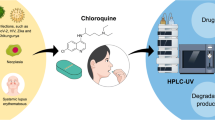Abstract
Carbazochrome (2-(1,2,3,6-tetrahydro-3-hydroxy-1-methyl-6-oxo-5H-indol-5-ylidene)-hydrazinecarboxamide, CBZ) and carbazochrome sodium sulfonate (5-[(aminocarbonyl)hydrazono]-2,3,5,6-tetrahydro-1-methyl-6-oxo-1H-indole-2-sulfonic acid sodium salt, CSS) are derivatives of adrenochrome currently employed mainly as hemostatic drugs. Since a semicarbazone group is present in both the structures of CBZ and CSS, semicarbazide hydrochloride (SEM) is used, as reagent, in their synthesis. Belonging to the hydrazine family of chemicals, SEM could possess some toxic potential. Accordingly, literature data showed that SEM causes osteolathyrism and induces toxic effects in the cardiovascular and skeletal systems. Moreover, SEM has a weak genotoxic activity in vitro while in vivo available data are not sufficient to state its genotoxicity. Based on these data, the determination of SEM as a synthesis-related impurity in CBZ and CSS drug substances is mandatory. Since there are no publications dealing with the determination of SEM in CBZ and CSS as well as in any other SEM-containing drugs, a new and unprecedented LC-DAD-UV method for its determination as impurity in CBZ and CSS drug substances was developed and validated. Due to the lack of chromophore, semicarbazide was converted into the corresponding UV-absorbing naphthalene-2-carbaldehyde semicarbazone (NCS) before the chromatographic analysis. The complete separation of NCS from the large concentration of the derivatization reagent and the parent drugs CBZ and CSS was accomplished through a liquid–liquid extraction (LLE) step followed by a chromatographic run of 10 min. The method was then successfully validated and its applicability demonstrated by the determination of SEM in real samples of CBZ and CSS.
Graphical Abstract






Similar content being viewed by others
References
Moriuchi H, Kashiwada Y, Arai I, Yuizono T (1995) Effects of carbazochrome sodium sulfonate (AC-17) on oleic acid-induced lung injury. Pharmacol Toxicol 77:238–240
Sendo T, Itoh Y, Aki K, Oka M, Oishi R (2003) Carbazochrome sodium sulfonate (AC-17) reverses endothelial barrier dysfunction through inhibition of phosphatidylinositol hydrolysis in cultured porcine endothelial cells. Naunyn Schmiedebergs Arch Pharmacol 368:175–180
Basile M, Gidaro S, Pacella M, Biffignandi PM, Gidaro GS (2002) Troxerutin-carbazochrome combination versus placebo in the treatment of posthemorrhoidectomy symptoms: a single-center, randomized, double-blind, placebo-controlled study. Curr Ther Res 63:527–535
Maranghi F, Tassinari R, Lagatta V, Moracci G, Macrì C, Eusepi A, Di Virgilio A, Scattoni ML, Calamandrei G (2009) Effects of the food contaminant semicarbazide following oral administration in juvenile Sprague-Dawley rats. Food Chem Toxicol 47:472–479
The EFSA Journal, 219 (2005) Opinion of the Scientific Panel on Semicarbazide in food:1–36
http://www.efsa.europa.eu/sites/default/files/scientific_output/files/main_documents/428.pdf. Accessed 25 Sept 2016
Abramsson-Zetterberg L, Svensson K (2005) Semicarbazide is not genotoxic in the flow cytometry-based micronucleus assay in vivo. Toxicol Lett 155:211–217
Takahashi M, Yoshida M, Inoue K, Morikawa T, Nishikawa A, Ogawa K (2014) Chronic toxicity and carcinogenicity of semicarbazide hydrochloride in Wistar Hannover GALAS rats. Food Chem Toxicol 73:84–94
Vlastos D, Moshou H, Epeoglou K (2010) Evaluation of genotoxic effects of semicarbazide on cultured human lymphocytes and rat bone marrow. Food Chem Toxicol 48:209–214
Wang Y, Chan HW, Chan W (2016) Facile formation of a DNA adduct of semicarbazide on reaction with apurinic/apyrimidinic sites in DNA. Chem Res Toxicol 29:834–840
Wang Y, Wong TY, Chan W (2016) Quantitation of the DNA adduct of semicarbazide in organs of semicarbazide-treated rats by isotope-dilution liquid chromatography—tandem mass spectrometry: a comparative study with the RNA adduct. Chem Res Toxicol 29:1560–1564
De la Calle B, Anklam E (2005) Semicarbazide. Occurrence in food products and state-of-the-art in analytical methods used for its determination. Anal Bioanal Chem 382:968–977
Wang Y, Chan W (2016) Automated in-injector derivatization combined with high-performance liquid chromatography—fluorescence detection for the determination of semicarbazide in fish and bread samples. J Agric Food Chem 64:2802–2808
Fang Z, Jiang B, Wu W, Xiang Z, Ouyang C, Huang T, Chen J, Zeng L (2013) ELISA detection of semicarbazide based on a fast sample pretreatment method. Chem Commun 49:6164–6166
Chumanee S, Sutthivaiyakit S, Sutthivaiyakit P (2009) New reagent for trace determination of protein-bound metabolites of nitrofurans in shrimp using liquid chromatography with diode array detector. J Agric Food Chem 57:1752–1759
Aprile S, Canavesi R, Bianchi M, Grosa G, Del Grosso E (2017) Development and validation of a stability-indicating HPLC-UV method for the determination of thiocolchicoside and its degradation products. J Pharm Biomed Anal 132:66–71
ICH, 3A (R2) (2006) Impurities in new drug substances. In: International Conference on Harmonisation, Geneva, Oct 2006
ICH, Q2A (R1) (2005) Validation of analytical procedures: text and methodology. In: International Conference on Harmonisation, Geneva, Nov 2005
Beaudet C, Debot F, Lambot H, Toussaint J (1951) The monosemicarbazone of adrenochrome. Experientia 7:293–294
Center for Drug Evaluation and Research, US Food and Drug Administration (1994) Reviewer guidance, validation of chromatographic methods; FDA, Rockville, MD, Nov 1994
Acknowledgements
Financial support from Università del Piemonte Orientale, Italy, (MedChem-2015) is gratefully acknowledged.
Author information
Authors and Affiliations
Corresponding author
Ethics declarations
Conflict of interest
The authors declare that there are no conflicts of interest.
Ethical approval
This article does not contain any studies with human participants or animals performed by any of the authors.
Electronic supplementary material
Below is the link to the electronic supplementary material.
Rights and permissions
About this article
Cite this article
Canavesi, R., Aprile, S., Del Grosso, E. et al. Semicarbazide Hydrochloride as Impurity in Drug Substances: a Validated LC-DAD-UV Method for Its Determination in Carbazochrome and Carbazochrome Sodium Sulfonate. Chromatographia 80, 1535–1544 (2017). https://doi.org/10.1007/s10337-017-3368-1
Received:
Revised:
Accepted:
Published:
Issue Date:
DOI: https://doi.org/10.1007/s10337-017-3368-1




